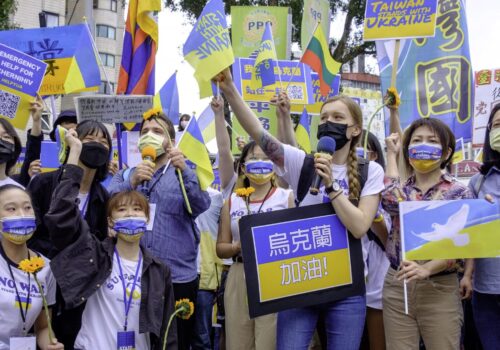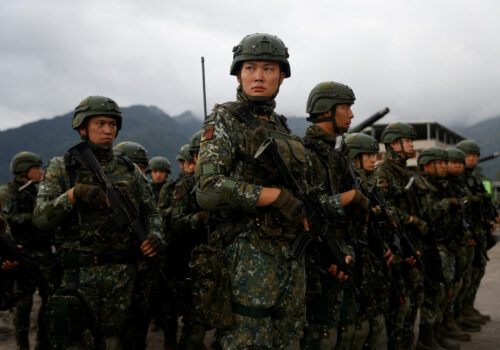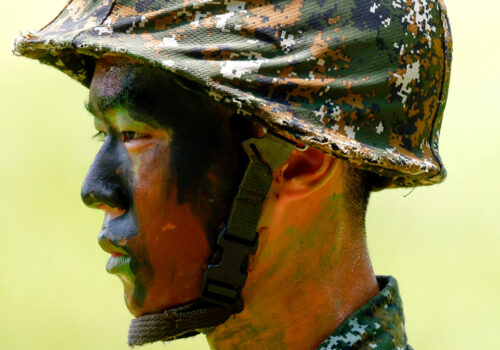Reading between the lines of Taiwan’s new Quadrennial Defense Review
Taiwan just released its 2025 Quadrennial Defense Review (QDR), a document that the government is obligated by law to produce every four years and within the first ten months of a newly elected president’s term. Due to the scarcity of official disclosure from Taiwan, reviews such as the QDR are often closely examined for their messaging and their presumed status as capstone documents for Taiwan’s defense policy.
In short, the QDR is an important window into what the Taiwanese military is thinking, albeit with some important caveats. In practice, Taipei does not use these reviews as a process to work out intergovernmental priorities and convey them to both government agencies and the general public. Instead, it is more of a “kitchen sink” document, a broad and somewhat disjointed collection of general opinions that often reflect conflicting views within Taiwan’s civilian and military bureaucracy and sometimes with its US partners.
In the past, both the Democratic Progressive Party (DPP) and the Kuomintang (KMT) in the Taiwanese legislature have found it difficult to hold the Taiwanese Ministry of Defense accountable based on the content of these legally mandated reports, which, in addition to the QDR, include the annual National Defense Review (NDR), the People’s Liberation Army Military Power Report, and the Five-Year Force Development Plan. Only the QDR and NDR are available on the Ministry of National Defense’s website despite the distribution of the other two documents to the press and, partially filtered, to the public.
So, what is in the 2025 QDR? The newest review does reflect some positive efforts by Minister of Defense Wellington Koo, the first civilian defense minister in twelve years. It reaffirms the existing defense posture of “resolute defense and multi-domain deterrence,” with a unique twist from the Lai administration of emphasizing “whole-of-society resilience.” This reflects Lai’s recognition that every aspect of Taiwanese society would likely be under assault by the People’s Republic of China during and even before a conflict, including through disinformation. In addition, Koo’s intent to minimize duties unrelated to operational readiness for the troops, and to leverage Taiwan’s technology ecosystem for commercial off-the-shelf solutions, also shines through in the review.
While the transparency of Taiwan’s military affairs remains to be improved, it’s still possible to extract useful observations by understanding that such aspirational language often points to lingering issues that need to be solved. Indeed, the declarations in these documents are sometimes tacit acknowledgements of severe issues that require collective attention not just from the Taiwanese government and its people but also allies and partners working closely to shore up Taiwan’s deterrence against China. This is certainly the case with the language in this year’s QDR, which points to persistent issues with prioritization, operational readiness, and manpower retention.
1. Taiwan lacks strategic prioritization
Modeled after the United States’ three-tiered defense planning system, the 2025 QDR launched with two brief sections, respectively titled the National Defense Strategy (NDS) and the National Military Strategy (NMS). Unlike the US model, Taiwan’s publication did not include a National Security Strategy (NSS). In fact, Taiwan has not had an NSS for almost twenty years, with the last revised NSS published in 2008 under the Chen Shui-bian administration.
The lack of an NSS from Taiwan’s National Security Council, a chronic issue acknowledged by both the DPP and KMT, has impacted every Taiwanese administration’s ability to coordinate and execute a coherent security posture. Since the essence of a strategy is what it prioritizes, the lack of a declared priority to the public is a persistent issue hampering Taiwan’s defense efforts and the transparency required for civilian control of the military. This is reflected in the NDS section of the QDR, with “disaster relief,” “regional stability,” and “economic prosperity” listed alongside “enhancing military power” and “revolution of military affairs.” This suggests that these goals are equal and sometimes competing objectives. Failing to prioritize these goals in the QDR means failing to signal to policymakers which of these objectives is most important, making efforts to tackle them more susceptible to narrow bureaucratic and partisan interests.
The consequences of lacking top-tier priorities for the three-tier NSS/NDS/NMS system becomes even more pronounced as a reader advances down to the NMS, where whole-of-society resilience is listed as a priority—even though this is outside of the Ministry of National Defense’s purview. And it is unclear how the Ministry of National Defense would be able to work on the issue across the bureaucratic divide—a lingering issue that the QDR fails to address.
2. Readiness is improving but remains an issue
One issue the QDR does highlight through its recommendations is military readiness. The QDR goes into excruciating, but not comprehensive, detail on actions that should be taken to improve Taiwan’s operational readiness. These include “conduct realistic exercises and training. . . so that servicemen can be acquainted with their areas of responsibilities,” “battle positions and rules governing contingency responses,” “distribute logistic and stockpiles closer to tactical positions,” and “establish mobilization digital database categorizing talent . . . based on operational requirements.”
While these are seemingly routine descriptions of a well-functioning military, the fact that these are highlighted indicates that these issues, long whispered between the rank and file, are finally being faced by leaders. However, the persistent lack of transparency for Taiwan when it comes to the nuts and bolts of defense issues somewhat hamper the positive messaging. While there are obvious trade-offs between the need to keep certain national security information secret and the right of citizens to know, it should not be forgotten that public support through information disclosure could bring much-needed positive changes within the force.
3. Manpower retention and low morale are problems
The QDR also points to the Taiwanese military’s persistent difficulties with low morale and manpower retention. It includes recommendations such as “put particular emphasis toward on-the-job training and compensation to increase retention of talents” and “reinforce [the troops’] belief and enhance morale.” Taiwan is losing its professional military corps at an alarming rate, with some even willing to pay the fine for early separation from service. These issues are particularly salient for the crucial mid-career officer and enlisted cadre, and they have persisted despite studies pointing to problems such as the military’s lack of focus on its mission and training.
While implicitly acknowledging manpower retention and morale issues, the QDR’s recommendations fall far short of what’s needed to turn the situation around given the scale of the problem. It simply recommends “humane” management, “encouraging” active-duty personnel to acquire advanced degrees, and producing more “educational videos” for servicemembers.
The Taiwanese people deserve more transparency
For the past decade or so, decision makers on both sides of the Pacific have understood that the strategic center of gravity for the fight in Taiwan is the hearts and minds of the Taiwanese people. The people of Taiwan are resilient, and they have increasingly solidified around a unique identity in lieu of Beijing’s notion of “Chinese on both sides of the Strait.” This is despite the fact that Taiwan has faced a gradual tipping of the odds against it in the waters around it, increased international isolation, and persistent psychological and information operations from Beijing. The Taiwanese people deserve more transparency and honesty from their military on critical issues concerning their security.
Almost half of Taiwan’s population does not believe the military can sufficiently defend it against a Chinese invasion, yet over 70 percent of the population expressed a willingness to fight for Taiwan. It is abundantly clear that people know there are significant problems with Taiwan’s military even when the government is less than transparent about it. Adopting a more transparent public posture—disclosing the challenges the military faces and its efforts to address them—could go a long way toward harnessing the Taiwanese population’s will to fight. This, in turn, will further boost the population’s confidence in the government and military’s efforts to solidify Taiwan’s deterrence against China.
Kitsch Liao is an associate director of the Atlantic Council’s Global China Hub. Previously, he worked in the US Congress, in diplomatic postings, and as a cyber intelligence analyst for the private sector.
Further reading
Thu, Feb 13, 2025
To secure Taiwan, the United States must first secure Ukraine
Issue Brief By Brian Kerg
US defense priorities appear to be at a crossroads. Can the United States materially sustain Ukraine in its fight with Russia while preparing for a possible fight with China in defense of Taiwan?
Wed, Aug 21, 2024
How quickly can Taiwan integrate US weapon systems? Speed is essential to help deter China.
New Atlanticist By Adam Kozloski
To better prepare Taiwan to defend itself, the United States needs more transparency into Taipei’s weapons integration challenges.
Fri, Jun 28, 2024
Dispatch from Taipei: Why Taiwan’s survival may depend on deterrence through resilience
New Atlanticist By Markus Garlauskas
A repeated theme in recent discussions in Taipei was Taiwan’s ability to withstand Chinese coercion and to adapt and sustain its defenses while under attack.
Image: A soldier stands on an M1167 TOW carrier vehicle at the Fangshan training grounds in Pingtung, Taiwan, August 26, 2024. REUTERS/Ann Wang



